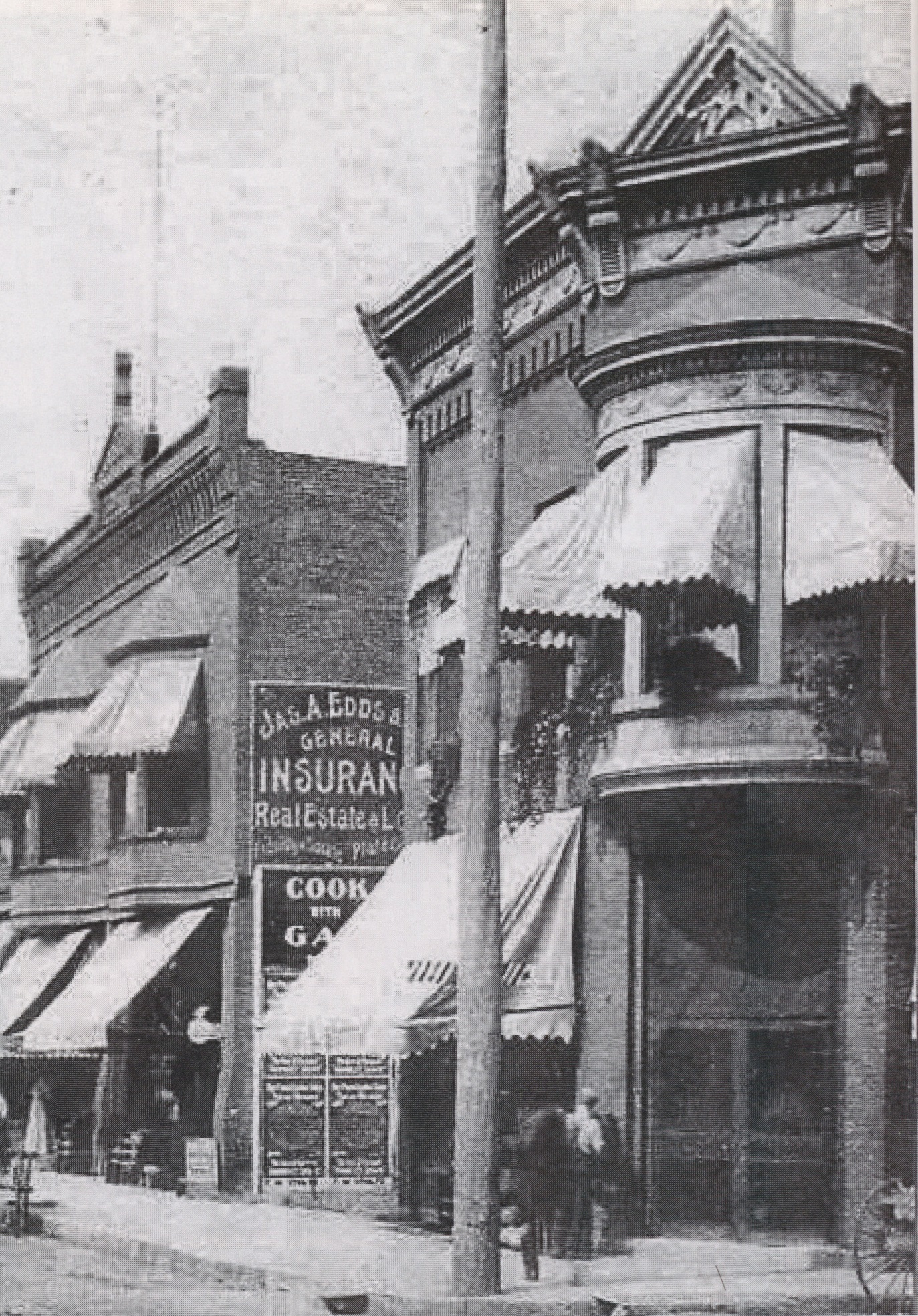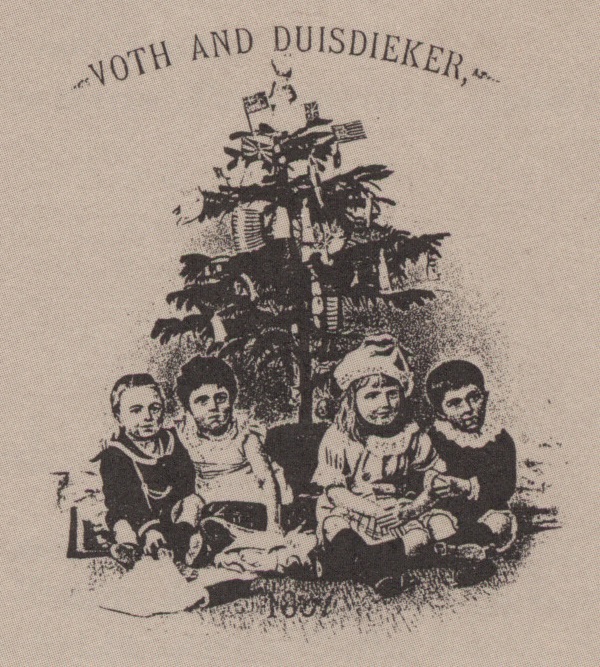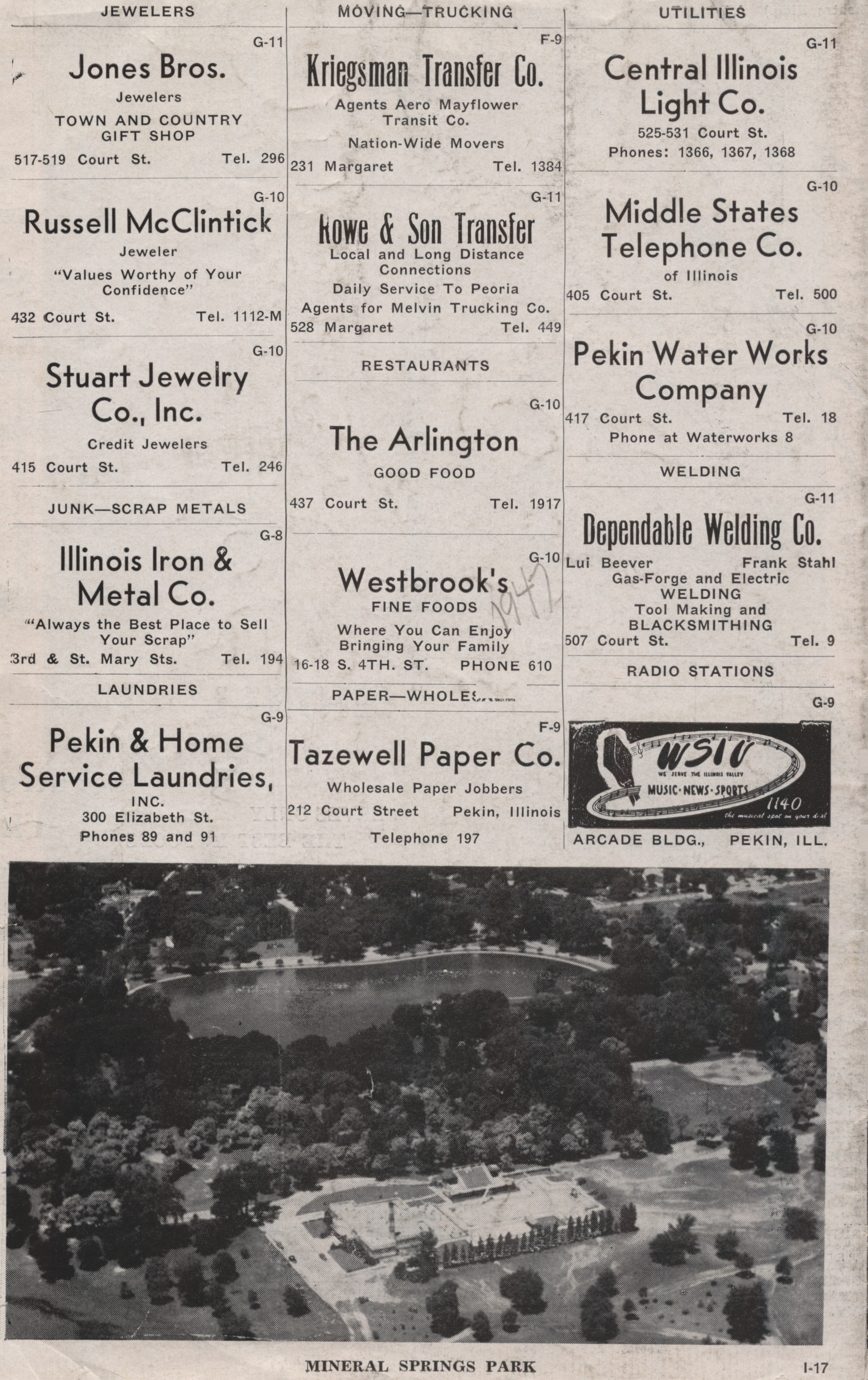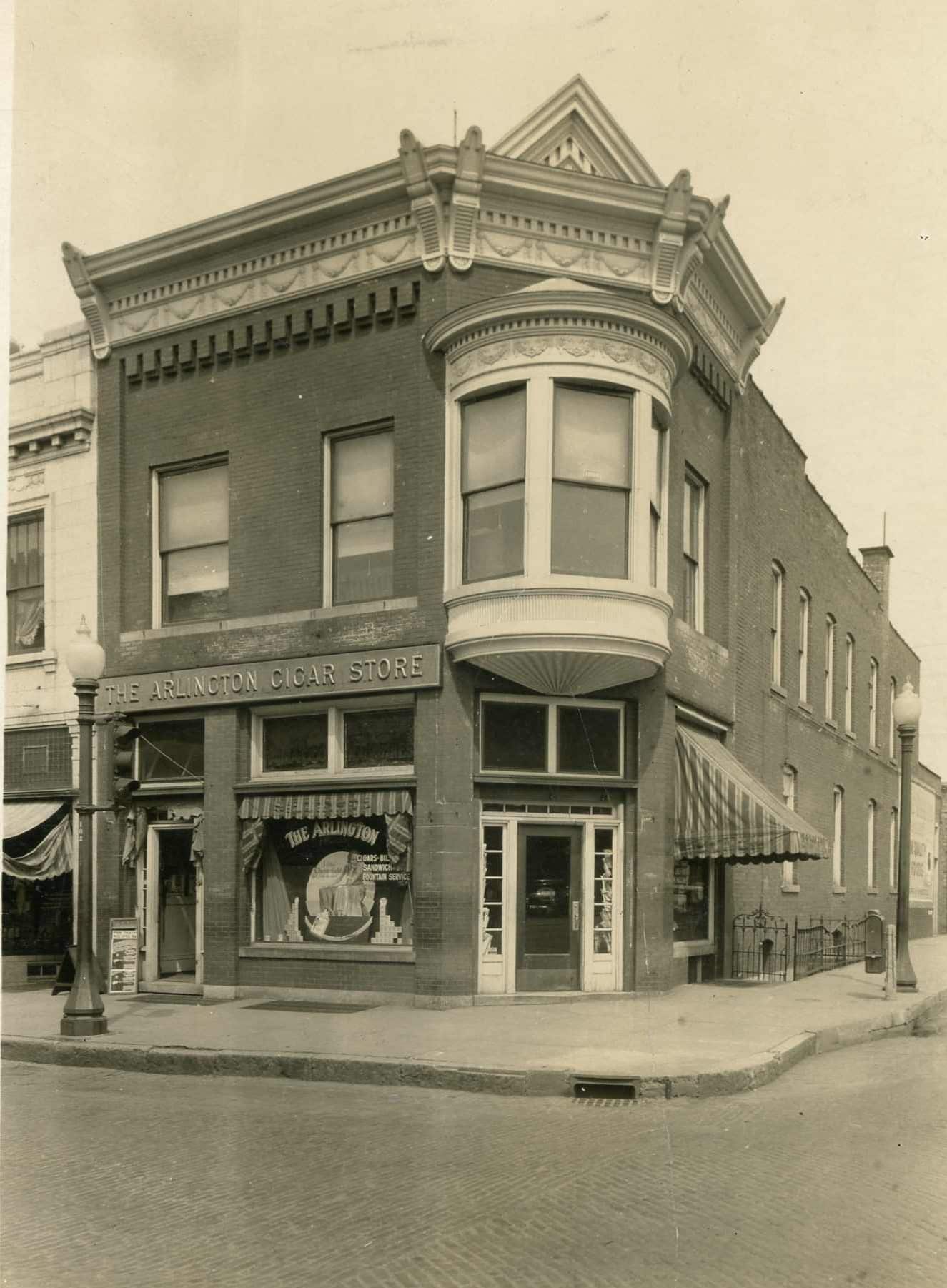The building at 437 Court St. – known to longtime Pekin residents as The Arlington – recently got new owners – Gambetti Girls LLC – who are now engaged in restoration and preservation work on this historic downtown structure.
“My daughter Baylee and I are enjoying imagining all the possibilities 437 Court has to offer as we peel back the layers to get it back to as close to its original state. We are ‘giving it lots of love’ to secure and protect the building so our community can enjoy it for the next 100 years,” said Terri Gambetti of Gambetti Girls LLC.
“Leo’s Art Studio will relocate here. Our dreams include a Visual and Performing Arts Center with some nice retail in the front of the building. We plan to add many other types of art lessons, and have performances with local talent. Phase 2 is to rehabilitate the second story, which has a ton of possibilities as well.”
Situated at the northwest corner of Court and Fifth streets, The Arlington Building, with its distinctive second-floor round corner bay window, has been a landmark of downtown Pekin since the first years of the 20th century, and has been many things throughout its history, including a barbershop, newspaper offices, home of the Pekin YMCA, a movie theater, a cigar store, a printing house, a diner, and a tavern.


This building’s history reaches back about 120 years, as shown by Pekin city directories and Sanborn Fire Insurance Maps. The Tazewell County Assessor’s website, however, says the structure was built in 1930, but that would have been the date of a later major remodel or expansion.
Before the construction of The Arlington Building, city directories enable us to trace The Arlington’s “pre-history” and learn what businesses first operated at the northwest corner of Court and Fifth streets.
The 1861 Pekin city directory shows that corner to have been the site of Mathias Eisner’s shoemaker’s shop. It is unknown what Eisner’s shop looked like, though.

Ten years later, the Sellers & Bates City Directory of Pekin shows that the corner was occupied by a firm known as Voth & Sackenreuther, manufacturers of wagons, plows and agricultural implements. Voth and Sackenreuther were Henry E. Voth (1830-1900) and George Paul Sackenreuther (1831-1886), a pair of German immigrants who became successful Pekin business owners. Voth had arrived from Germany in 1853, served as an alderman on the Pekin City Council from 1878 to 1883, and was an elder at St. Paul’s German Evangelical Church (now St. Paul’s United Church of Christ).

Voth & Sackenreuther owned and operated a foundry and rail fence factory at the northwest corner of Courth and Fifth, according to the 1876 city directory. By the time of the 1887 city directory, however, Sackenreuther’s place in the firm had been taken by another German immigrant named Charles H. Duisdieker (1851-1925), who came on as partner in 1886 following Sackenreuther’s death.
According to the 1887 city directory, Voth and Duisdieker co-owned the Voth & Duisdieker foundry that year at the corner of Court and Fifth, then numbered 535-539 Court St. Duisdieker’s biographical sketch in the 1905 “History of Tazewell County,” however, tells a slightly different story:
“In 1889 (sic) the senior member of the firm [i.e., Voth] disposed of his interest to Mr. Smith, and the company was conducted under the firm name of Duisdieker & Smith until 1889, when Mr. Duisdieker became the sole proprietor. The plant now employs forty or fifty men, and does high-class work, the manufactures being the J. C. Sharp stump extractors, castings for the Western Steam Generator Feed Mills, Cyclone emery grinders, and iron and brass castings.”
There is obvious a typographical error in this passage of the 1905 history – probably the first “1889” is an error for, say, “1887” or “1888.” A vintage photograph of the foundry taken in the late 1880s displays the firm’s name of Duisdieker & Smith, but I have not yet determined which “Mr. Smith” was Duisdieker’s partner.



In any case, the 1893 Pekin city directory listed the Duisdieker Foundry and Manufacturing Co. with Charles Duisdieker as sole proprietor. Most notably, the directory says that after 1 May 1893, the foundry would be located at the corner of Susannah, Third and “Isabella” (Sabella) streets. That is when the Duisdieker foundry left the northwest corner of Court and Fifth, and the 1895 and 1898 directories have no business listing at all for that corner. It is the 1892 Sanborn Fire Insurance Maps that last shows the foundry at Court and Fifth. The 1898 Sanborn map shows that the foundry had been torn down – the two adjoining lots at the northwest corner of Court and Fifth were empty that year.


Then in the 1902 city directory, we find a listing for a W. H. Woost as well as Haake and Son at 437 Court St. The 1900 U.S. Census for Pekin shows William Woost, 38, painter and wallpaper hanger, the son of German immigrants, living at 410 Court St. with his wife Carrie – this was William Henry Woost (1862-1935), son of Henry W. C. Woost.
The next year, in the 1903 city directory we find Rudolph Haake (1869-1956) and Louis Schleder (1868-1941), barbers, at 437 Court St. That is also the same year that the Sanborn Fire Insurance Maps show the building that later became known as The Arlington, occupying the eastern lot of the two lots where the Duisdieker foundry had been. The new building therefore must have been constructed between 1898 and 1902. The Haake & Schleder Barbershop is said to have operated out of the basement of the new structure.

In the 1906 directory, we find that A. L. Smith was operating a grocery store and meat market at 437 Court St., while the Young Men’s Christian Association (YMCA) was on the second floor. In the 1908 city directory, Smith was operating a grocery store at 437 Court St., while upstairs in the building was the apartment where John A. Weber, druggist and pharmacist, lived (Weber’s pharmacy was nearby at 432 Court St.). The following year, however, Smith’s grocery store had closed, but Weber was still living upstairs.

In 1910, we find a directory entry for the Post-Tribune newspaper and the Eagles Hall at 439 Court St. That same entry is repeated in the 1911 and 1912 directories. The following year, the 1913 city directory says The Court Theatre was then located at 439 Court St. – this is the same building that earlier directories numbered as “437” Court. Still in the building this year, on the second floor, was the Eagle Lodge (with its entrance at 7 N. Fifth St.) along with the Maennerchor Hall.
The 1914 directory’s entry for this building is much the same as it was in 1913, only the printing shop of Henry S. Kettenring (1875-1930) had moved into the basement of the building. The building’s number is given as “437” Court St., but the Eagle Lodge is still said to have the address of “439” Court. The 1914 directory entries for this address are repeated in the 1915, 1916, and 1918 directories.


Curiously, the 1921 city directory does not have any entries for “437” Court St. or for The Court Theatre, but Kettenring’s printing shop is still shown in the basement at “439” Court St. The Court Theatre reappears at 437 Court St. in the 1922 city directory – that year, the directory lists William James Dittmer (1882-1962) as the theater’s proprietor, with John C. Losch as owner and operator of the theater’s popcorn stand — this appears to be the same John C. Losch who was captain of the Frankie Folsom, which sank on Peoria Lake in 1892. We find the same thing in the 1924 city directory, which shows the theater on the main floor of 437 Court St., S. E. Russell, manager, with the Kettenring Printing House in the basement (which had the street address of 439 Court St.).

It was around that time that The Court Theatre closed at 437 Court. The 1925 Sanborn Map of Pekin shows a “Garment Sewing” business on the second floor of 437 Court St., but that business is not mentioned in the city directories. The 1926 Pekin city directory features the debut of “The Arlington” at this address, showing an entry for the “Arlington Cigar Shop,” owned and operated by John Frederick Gehrs (1888-1949), with “Gus Karras” (sic) as the store’s shoe shiner. Gus Karas/Kares/Karis was a Greek immigrant – his proper name appears to have been Konstantinos Karahalios.
That was not the first downtown Pekin business to bear the name “Arlington” – prior to the opening of the Arlington Cigar Shop at 437 Court St., city directories show that Louie Hoff ran the Arlington Pocket Billiard Parlor at 431 Court St. (1914-1918 directories) or 428 Court St. (1921 directory). Louie Hoff briefly ran a bookstore at 341 Court St. in the early 1920s.

The 1926 directory says 437½ Court (probably the building’s upstairs space) was then vacant, while Henry S. Kettenring was still operating his Printing House from the building’s basement (439 Court).
Kettenring Printing House in the basement of the Arlington Cigar Shop building last appears in the city directories in 1928, two years before Kettenring’s death. Henry Kettenring’s obituary in the Pekin Daily Times says that in 1928 he had erected a new structure called “the Kettenring Building” on North Fifth Street. The 1930 city directory says that building, the new home of the Kettenring Printing House, was located at 12 N. Fifth St. – still standing in 1988, it has since been torn down: the site is part of the parking lot next to Ace Liquors.
By the time of the 1930 directory, John F. Gehrs had sold the Arlington Cigar Shop to Robert Mosby Ewing (1883-1943) of Peoria, though Gus Karas stayed on as shoe shiner. Only in the 1928 city directory but in no other years, Paul B. Buckley appears as a partner in the business with Ewing.
By 1934, Ewing had changed the cigar store into the Arlington Store restaurant, serving lunches and fountain drinks and beer on draught – though you could still get smokers’ supplies. The original shoe shiner Gus Karas left Pekin in the late 1930s, and in 1937 Thomas C. Theleritis (1891-1982) replaced him as the Arlington’s shoe shiner. In 1939, however, Theleritis was operating the Arlington Hat Works upstairs at 437 ½ Court St. while continuing to offer shoe repair and shoe shining. City directories continue to show Theleritis, “hatter,” at that address until the end of the 1950s, and one year, in the 1952 Pekin city directory, Chris Theleritis is listed as his attendant — Chris later was manager of Del Farm Grocery Stores in Pekin and Peoria.
After Ewing’s death in 1943, his widow Hazel H. (Sholl) Ewing (1886-1975) continued the business as just “The Arlington” (dropping the word “Store”). She first appears as owner in the 1946 directory, and that same year she was also operating The Arlington Club, a tavern at 9 N. Fifth St. Beginning in 1952, proprietorship of The Arlington Club tavern passed to Camile A. Munge (1925-1989) and Gerved Oltman, but Hazel Ewing remained as owner and operator of The Arlington itself.


Hazel Ewing ran The Arlington until the mid-1950s, but in the 1955 city directory we see that Harold L. Marrs (1913-1996) had taken over the restaurant. He operated The Arlington until 1978. (A curious detail is that the Pekin city directories frequently misspell his surname as “Marss”.)
The 1961 directory shows that Paul Tortorice had taken over the hat works and shoe shine parlor at 437½ Court St., but Tortorice was in turn succeeded by Merl Trenholm in the 1962 directory. But by the 1960s both hat-wearing and getting one’s shoes shined had fallen out of fashion, and so in the 1964 city directory we see that the old hat works and shoe shine parlor had been replaced by Arthur E. Bailey’s Arlington Barber Shop. Bailey ran his barbershop at 437½ Court until 1968, but that address was listed as “vacant” until the 1972 directory, when Clarence Buck briefly operated Buck’s Lock & Key Shop there. But soon after that Buck moved to Marquette Heights, and the Arlington Barber Shop reopened at 437½ Court under the proprietorship of Russell G. C. Beaver (1912-2001), as shown in the 1973 directory.

In the late 1960s and early 1970s, Harold L. Marrs’ wife Alyce Vivian Marrs (1919-1991) usually appears as co-owner of The Arlington. Harold Marrs is last listed as owner of The Arlington in the 1978 directory – he sold the building at 437 Court St on 3 July 1978. From 1979 to 1984, The Arlington was owned and operated by Larry Noreuil (1944-2019) and Leo E. Berardi – they sold the building on 1 Feb. 1985. In the 1985 directory 437 Court St. is listed as “vacant,” although Russell G. C. Beaver still had his Arlington Barber Shop upstairs at 437½ Court.
The Arlington at 437 Court remained vacant until the time of the 1988 directory, when Mrs. Irene D. Tunkis (1925-1990) reopened it and ran it for a year or two before her death. In the 1990 directory, however, we find that Mrs. Glenda R. Miller (1941-2020) had taken over in 1989 and changed the name to Arlington Club, operating the business as a tavern or bar until 2003. The 1990 directory also shows that Russell Beaver’s Arlington Barber Shop moved from the building to 514 Court St., though keeping its name.
By 1997, the tavern’s name was changed to “Miller’s Arlington Club,” and in 2001 we see that the tavern was operated by Glenda’s husband Richard Clayton Miller., who was co-owner with her of 437 Court. In the 2004 city directory, we find that the tavern’s name had been changed the name to “Instant Replay Sports Bar.” Instant Replay last appears in the directories in 2018.
From 2019 until this year, the directories do not list 437 Court St. at all. But thanks to the building’s new owners, that will soon change.












